CARAVANNING WITH A TINNY
Ed Palnok suggests that taking a small boat along on your next fishing/camping holiday will open up a whole new range of possibilities.
Hitching up a caravan has long been a popular way to travel and holiday. It’s easy to see why, since you always have all the necessary creature comforts following along behind and it enables you to access so many beautiful, out-of-the-way places our state and Australia have to offer.
COVID 19 saw a dramatic increase in caravan interest and purchases, but the high demand also caused supply chains to suffer, with lengthy delays in new vans and the second-hand market prices soaring well above normal. Caravan traffic had never been so high, and unfortunately many caravan parks have taken the opportunity to jack up prices. However, it remains a relatively cheap form of accommodation and, if set up to be off grid, costs can be next to nothing or, in many cases, free. For those keen to fish, caravanning provides the best of both worlds; you get to travel to some fantastic, often less crowded locations and drop a line trying to catch a feed. We also know that if you can add a boat into the fishing scenario, a whole new range of opportunities becomes available.
For a long time, an extended trip to the tropics up north was high on my caravan/fishing bucket list. Casting lures for barramundi in the rivers of the Northern Territory, trolling baits for Broome’s pelagics and jigging Exmouth’s inshore reefs were my main objectives. Clearly, to achieve these goals, a boat was required. My partner Sally, a keen, competent fisher herself, also shared my enthusiasm for this trip, but with one absolute non-negotiable — if we were to be fishing in crocodileinfested waters, she demanded a boat with the deepest hull and highest sides possible for its size. I couldn’t argue with her logic.
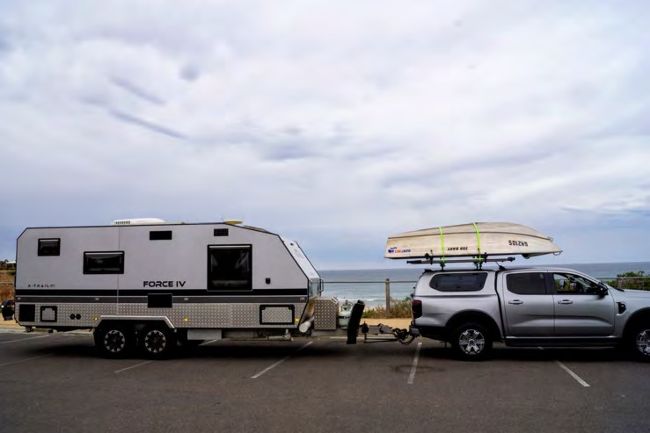
Loaded up and ready to hit the bitumen
Obviously, with a caravan in tow, the boat we purchased would need to be a tinny that could be carried on the roof of the tow vehicle. Now, as all caravanners know, there is one critical factor that must be kept front of mind when loading your rig — weight. It is incredibly easy to overload the caravan and tow vehicle, and when a tinny with its outboard, fuel and associated safety gear is factored into the equation, too much weight very quickly becomes a big issue.
There are several weightrelated considerations, including the gross weight/mass the tow vehicle can carry (including the towball weight), known as GVM, and GCM, which is the gross combined weight/mass of tow vehicle and caravan. A vehicle’s GVM and GCM values can be found on compliance plates or inside the car’s front door arches. Detailed explanations of these and other towing weight requirements are available on-line or via printed materials, so I am not going into them here. Suffice to say, Sally was disappointed to learn that these weight restrictions meant we could not strap a 6m runabout on to the car’s roof racks.
After a little research, a Quintrex 350 Dart was purchased. This is a 12ft aluminium with best-in-class depth of 83cm and weighing just 78 kg. Its good hull depth was somewhat reassuring to Sally, but it is quite sobering when you are in a 3.6m tinny cruising passed a 4m crocodile basking on the bank. Initially, it does make you feel like you’re fishing from a postage stamp! However, over many years we have seen lots of crocs, sharks and whales, and the Dart has performed faultlessly and met our needs perfectly.
The Dart’s weight of 78kg was also a very appealing factor. Our tow vehicle is a Ford Ranger ute with a reinforced canopy that’s rated to carry up to 150kg. This addition has meant the tinny and the 28kg boat loader used to put it on the canopy are accommodated well inside the canopy’s carrying capacity. A ute with canopy does provide an enormous amount of weatherproof storage, so it’s essential when caravanning, let alone with a boat as well.
It is worth highlighting an important restriction regarding all ute-type vehicles. Because the tub and passenger cab are separate from each other, when travelling they move up and down and flex independently. If a rigid object (like a boat) is attached to both tub/canopy and the cab, damage can occur to either. For this reason, the boat must be mounted above the passenger cab or the tub/canopy, but not both simultaneously. This is not an issue for sedans and station wagons, but they often don’t have the same amount of storage and their roof carrying capacity must be checked carefully!
Unless you have a couple of strong friends, a boat loader is needed to lift the tinny onto the roof of the tow vehicle. We have used a Rhino rack side boat loader for many years and can highly recommend them. There is also a rear loader option, but I prefer the side-on set up because you can lower or raise your tinny with the caravan still connected to the car. The side loader system consists of two ramps, which slot into its side and then four ropes click onto eyelets that have been screwed to the sides of the tinny. A portable drill is then connected to the loader’s small gearbox and you simply pull the drill’s trigger and up goes the boat. It really is a very clever, simple process that enables you to both launch and retrieve single handed.
Boat Hoist is a company located on Queensland’s Sunshine Coast that has developed a side boat loader that can be mounted on a ute’s canopy and passenger cabin without any concerns of damage due to their independent movement. The system allows the supporting bars to slide back and forth as each supporting rack moves differently. Speaking to several people on our travels who are using these loaders, all have been very pleased with them and reported no issues.
While using a loader to launch or retrieve is a relatively quick process, its not something you want to be doing on a busy ramp with a mob of impatient boaties waiting behind you. If your aim is stay in a location for some time and leaving the boat moored on water is not an option, you need a trailer unless you are prepared to lose a lot of time and energy on each trip. There are quite a few decent collapsible trailers on the market and one of the most popular is manufactured by Mangrove Jack, based in WA. The trailer only weighs 38kg, (there’s that weight issue again), it’s constructed from rust proof stainless steel and aluminium, and needs no tools to put it together because it has no nuts or bolts! To assemble, the holes of individual parts are aligned and then a patented spring-loaded gravity pin is inserted, locking the components together. It’s really ingenious! In fact, once the individual parts are laid out on the ground, the trailer can literally be assembled in about two minutes! Mangrove Jack also supplies brackets so the trailer can easily be mounted on the rear bumper of the caravan — secure and out of the way without taking up precious space.
Although I am now getting a little long in the tooth, I can still manage to lift the 15HP outboard onto the lowered tailgate of the Ranger. However, manoeuvring it around inside the ute’s tub under the canopy has become more problematic. Outboard slides, similar to those used for portable fridges, are available, but they add more weight (!) and can be expensive. Using another slide bolted to the tub floor also reduces flexibility when packing larger items. My solution was a simple one. Using some marine ply, I fashioned a sub flat floor for the tinny, which is a very useful addition to keep tackle boxes and other items up out of the inevitable water that always seems to swill around the bottom of the boat. I found when this “floor” piece is placed on the open tailgate and the outboard rested on top, with very little force I can push both into the tub and even slide left or right as required. It is not only a simple, cheap solution, but its dual functionality reduces weight.
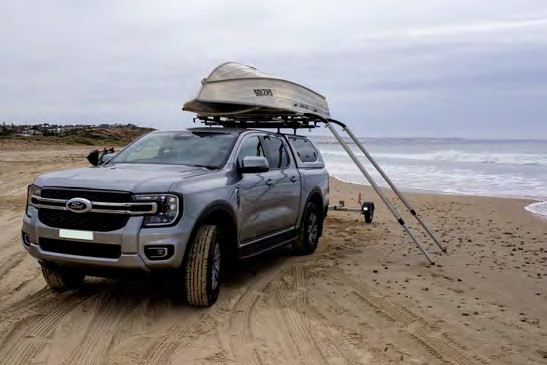
The Boat Hoist makes roof loading a tinny as easy as it gets
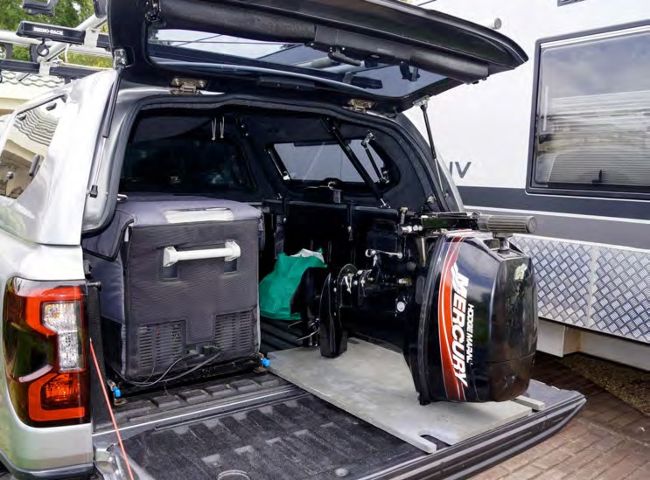
The little Merc two-stroke slips neatly under the Ranger’s canopy
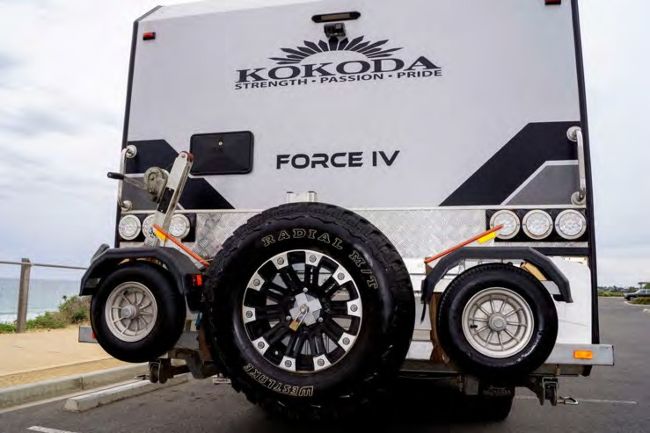
A collapsible trailer can be a handy optional extra
Regardless of whether you plan to camp at one location for an extended period or move frequently, the process of preparing the tinny and storing all the necessary gear needs to be as efficient as possible. With that in mind, how I store the gear in the shed at home is how it is packed in the car and used in the tinny. For example, the anchor, chain and ropes are placed in a large plastic tub that fits snugly at the front of the boat. Fire extinguisher, EPIRB, first aid kit, torch and other items that need to be kept handy, but dry, are stored in a canvas bag placed under the bow’s foredeck.
Even in a tinny, a sounder is an important addition to improve your chances of fishing success. It not only shows bottom structure and maybe even fish, but its depth indication is critical in shallow, dirty water. I use a plastic box, which is big enough to house the battery, cables and transducer. A couple of holes were drilled through the lid and the sounder’s monitor was screwed to the underside of the lid. The hard plastic box protects the sounder while stored in the shed and the ute. When in the tinny, the lid holding the monitor is simply turned upside down, placed back on to the box and strapped to the seat thwart, ready to go. A suction cup attaches the transducer to the hull, thus eliminating the need for nuts and bolts — a real advantage for quick removal to avoid damage during beach launches and retrieves. Using containers like these streamlines storage at home, in the car and in the tinny. They also reduce the chances of accidently leaving something at home!
SA’s coastline really is conducive to caravanning with a tinny. Our two gulfs provide reasonable protection from Southern Ocean swells, and the multitude of bays, especially on Eyre and Yorke Peninsulas, provide lots of sheltered inshore options out of the wind. Tinnies are lightweight and robust and, coupled with a 4WD, beach launching into some more remote spots is very manageable.
There are many fantastic caravan parks situated right on the foreshore and if camping off-grid is more your style, bush camping choices are plentiful as well. As a starting point to get some ideas, check out the WikiCamps Australia app, www.visityorkepeninsula.com.au/camping and www.eyrepeninsula.com.au/camping. No matter where you end up parking the van, the advantage of leaving the tinny anchored just offshore from your van is always tempting, but I offer these tips learned through bitter experience. Firstly, ensure your anchor (I suggest two) is securely buried in the sand to prevent strong overnight winds blowing your boat away! Secondly, before anchoring, check tides carefully so you don’t find your tinny high and dry next morning when you want to go fishing.
There may not be many freshwater rivers in our state, but the mighty Murray has you covered with its caravan parks, conservation parks and free camps. In fact, if you haven’t parked your van right on the riverbank with your tinny tied off to a gum tree less than 5-10m away, I suggest moving. There is something very special about waking in the morning, opening the caravan blinds to see your tinny floating close by as the mist rises off the river!
So, if you have a caravan or are thinking of getting one, consider adding a tinny to your plans. Trust me, you won’t regret it.
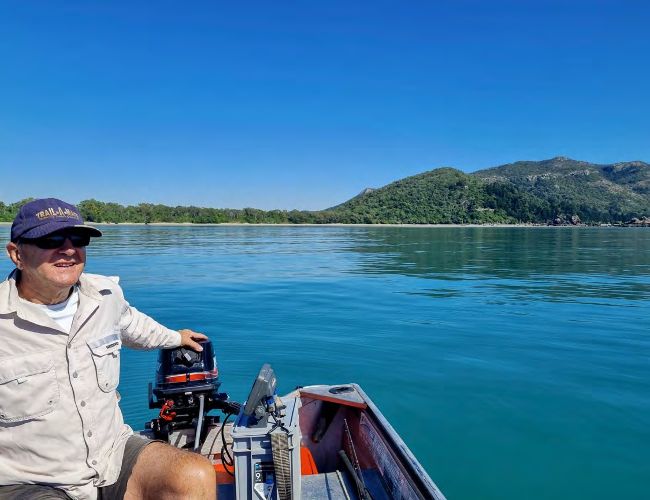
Taking a tinny on your next caravan holiday could really open up a host of possibilities